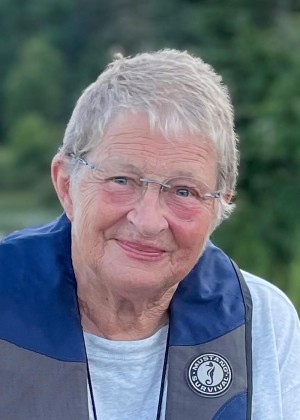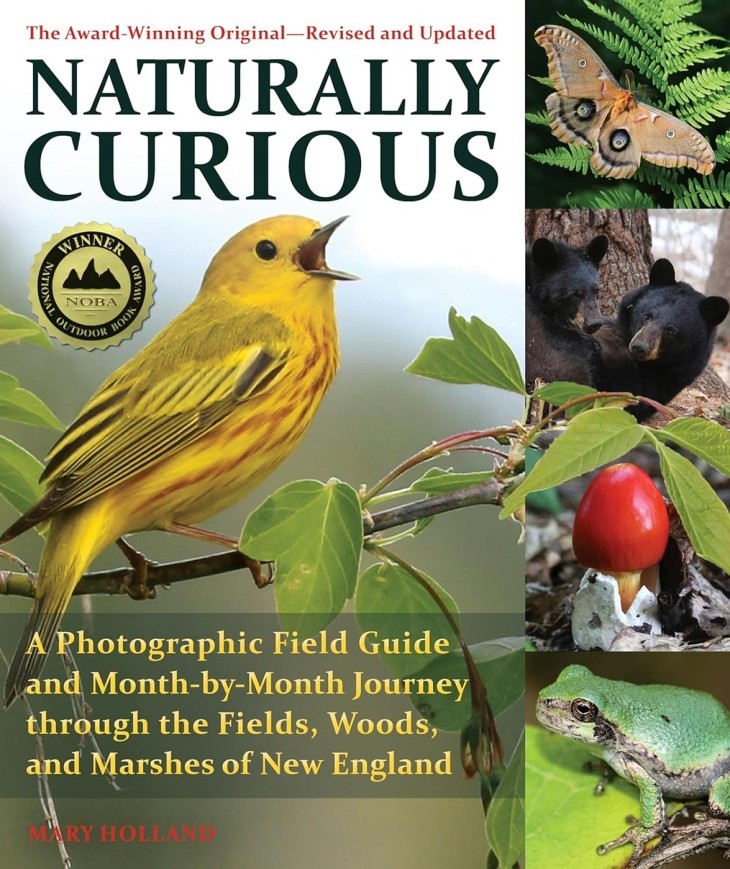Mary Holland is a Vermont-based author, naturalist, and photographer. She has written numerous books for children and adults, including the perennially popular Naturally Curious: A Photographic Field Guide and Month-By-Month Journey Through the Fields, Woods, and Marshes of New England, which was published by Trafalgar Square Books and which won a National Outdoor Book Award. She has developed and delivered nature programming for schools and organizations including Vermont Institute of Natural Science and Massachusetts Audubon Society. She continues to share her photographs and phenological discoveries through her blog, and each issue of Northern Woodlands magazine includes a Naturally Curious page.
Why do you write?
I write because I love to share my excitement and passion for the natural world with others, some of whom may not be as fortunate as I am to be able to spend time outdoors exploring. I write in the hope that if I can tweak an interest in the natural world in others, it might be a tiny step towards preserving and honoring the natural world.
What are you writing these days? What do you hope to write in the future?
Since writing Naturally Curious and Naturally Curious Day by Day, I’ve devoted most of my time to writing to a number of children’s books, the latest of which is called Snag It! and is about standing dead trees, or snags. I feel that the extent to which wildlife depends on them is not well known, and if I can shed some light on their role in the ecosystem for children (and their parents), it may benefit many creatures.
I also write short essays for my Naturally Curious blog, which I enjoy very much. Producing a photograph and a paragraph or two about a plant or animal that one might encounter at that particular time of year keeps me looking, learning, photographing, and writing, hopefully for the rest of my life.
If your adolescent self could comment on the fact that you’re a naturalist, writer, and winner of the National Outdoor Book Award, what would she say?
My adolescent self would be delighted that I found a way to support myself being outdoors much of every day! I had no idea you could earn a living teaching others about the natural world. I was brought up in the country, loving to explore, collecting all sorts of outdoor discoveries, and hating to dress up. My adolescent self would be amazed, though, to think that she would one day write a book that would be published, and that it would be acknowledged in such a gratifying way.
We’re you surprised by the rave reviews and popularity of Naturally Curious?
I was very, very surprised. My intention was to write the book that I wish I had when I was growing up. Something that I could leave my daughter with that would guide her through the year, throughout her life. I felt I had fulfilled my goal, and I felt good about how it turned out, but had no idea that it would be recognized and valued by my peers to the extent that it was.
What is your writing process?
It’s quite simple, really. First, I need to be inspired by something I experience with one of my senses. Nesting birds, a trilling toad, a bottle gentian being pollinated by a persistent bumblebee, a determined salamander heading for its ancestral breeding pool, an early blooming skunk cabbage, a woodcock in an aerial display. Next, I observe and photograph the subject. I then research it with both books and computer, after which I give myself ample time to assimilate what I’ve seen, heard, and read. Only then do I sit down and put my own words and perspective on paper.
What’s the best little-known nature book you’ve read?
I have always been interested in the order in which natural phenomena present themselves – when the first trailing arbutus flowers, when you first hear a gray treefrog’s trill, or your first glimpse of a woodchuck or killdeer in the spring. I have collected books which focus on this subject of phenology, including many written in the early 1900s. One of these is The Pageant of Nature by Gaylord Johnson, published in 1927. Short essays, detailed illustrations, and lists inform the reader of birds migrating, wildflowers in bloom, insects present, etc. It’s fun to compare with the 21st century.
What’s the best job you’ve ever had? The worst?
The best job I ever had was when I moved to Vermont in the ’70s to become the Education Director at Vermont Institute of Natural Science in Woodstock, Vermont. I got in on the ground floor when their elementary school program, ELF (Environmental Learning for the Future), was just being launched. I had the great joy of designing, along with two outstanding environmental educators, Jen Lingelbach and Judy Irving, hands-on natural history programs that, through our training of adult volunteers, reached elementary students throughout the state. Working with a team of wonderful naturalists, driving all over this beautiful state to give workshops, coming up with creative, educational, and fun ideas on how to convey natural history information to children – life doesn’t get much better than that!
The worst job I’ve ever had: bank teller. I lasted one day.
Who inspires you?
I am very fortunate in that I have encountered many gifted naturalists over the years, who have all contributed to my life and career. I shall always treasure and be inspired by experiences I shared with them that opened up a new perspective for me. Standing on the bank of a pond when I was relatively young, listening to a bird singing on an island in the pond and learning that it was possible to identify that bird without ever seeing it was one of my first profound experiences with one of these mentors. They are too numerous to mention, but they had an enormous effect on me.
Teaching children also inspires me. I identify with their innate curiosity and fascination with the natural world, and feel totally inspired as well as joyful being with little people with whom I share so much.
Are you reading or listening (podcasts or music) to anything great right now?
I’ve recently discovered Tristan Gooley and am currently reading The Lost Art of Reading Nature’s Signs. His writings have a different slant than most, in that they don’t attempt to identify species, rather they clue you in to what a given species tells you about the immediate environment. For example, the section on fungi mentions how you will find fly agarics in acidic woodlands and that they are a strong indicator that there are birches nearby. Lots of meaty facts!
In your opinion, what’s the most fascinating species in New England?
Hands down, to me the beaver is the most fascinating species anywhere. I had an early encounter with beavers when my Labrador retriever was enticed by beavers who intended to drown their perceived threat (my dog). I ended up having to enter icy water (it was April) to rescue my dog. From then on, I found myself fascinated by these incredibly clever rodents.
I have spent hours at beaver ponds, watching them forage on land, grooming themselves and mutually grooming each other, building dams, building scent mounds, establishing trusting relationships with humans, etc.
Another fascinating aspect that puts beavers at the top of my favorite species list is the number of adaptations they have evolved: nictitating eyelids, nose valves, ear valves, fat storage in their tails, temperature regulation, split toenails for grooming – the list goes on and on.
My interest and fascination with beavers has led me to investigate the interior of lodges where the water has receded enough to allow me to squeeze my way into them. It’s great fun to experience being in a spot no human has probably ever been before, and to see firsthand the amazingly symmetrical ceiling they have carved with their teeth. I feel privileged to have been able to spend as much time as I have with these fascinating creatures.
How often do you observe something in the forest you’ve never seen before?
Certainly not every time I go out do I find something new and different, but when I do, it absolutely makes my day. I most recently experienced this when I discovered a pinkish-red growth on a rotting log that I assumed was a fungus. It was new to me, so I photographed it and went home to see if I could find it in one of the many books I’ve collected over the years. I know there are many digital ways of identifying something, and I do often use them, but on this occasion I enjoyed learning from my own library that I had discovered not a fungus but red raspberry slime mold, a species I had never encountered before.




Discussion *